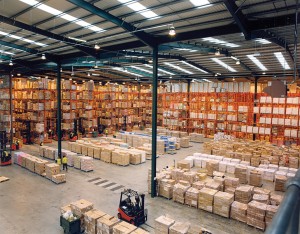 Reducing inventory is one of the goals of lean manufacturing. In my last post I described why we need inventory in the first place, and why too much inventory is bad for you. Now let’s look at how we can achieve a good inventory level. First, an important statement: Inventory is not a lever that you can pull. It is more the result of other good lean improvements. In fact, merely pulling this lever and reducing inventory will actually make things worse. To gain the true benefits of lower inventory, other measures have to be taken. In this post I would like to describe what happens if you simply reduce inventory, and how to do it to achieve a lower inventory without causing mayhem in the process.
Reducing inventory is one of the goals of lean manufacturing. In my last post I described why we need inventory in the first place, and why too much inventory is bad for you. Now let’s look at how we can achieve a good inventory level. First, an important statement: Inventory is not a lever that you can pull. It is more the result of other good lean improvements. In fact, merely pulling this lever and reducing inventory will actually make things worse. To gain the true benefits of lower inventory, other measures have to be taken. In this post I would like to describe what happens if you simply reduce inventory, and how to do it to achieve a lower inventory without causing mayhem in the process.
Simply Reducing Inventory Will Achieve the Opposite
Often, upper management decrees that the inventories have to be reduced. “Inventory is expensive. Toyota has little inventory, and we want to be lean, hence we reduce inventory.” Middle management then follows these wishes and order less parts, hoping that the inventory will go down.
However, this inventory has a function. These parts serve a purpose, namely to buffer and to batch. If we simply reduce the number of parts, they can no longer fulfill their function. The number of missing parts will increase, as will the number of unfulfilled customer orders. Hence both your productivity and delivery performance will go down.
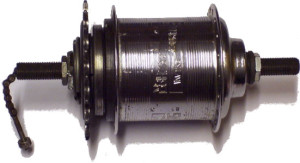
And now for the double whammy: Your parts will not be missing equally. Most raw material will still arrive on time. Except, the one part missing means you often cannot use any of the material. If you wanted to produce 1000 products, each product needs 100 different parts, and one part is missing…Congratulations! You just increased your inventory by the material for 1000 complete products (minus one part). Hence, simply decreasing inventory may actually increase your inventory due to missing parts, on top of a worsening productivity and delivery performance.
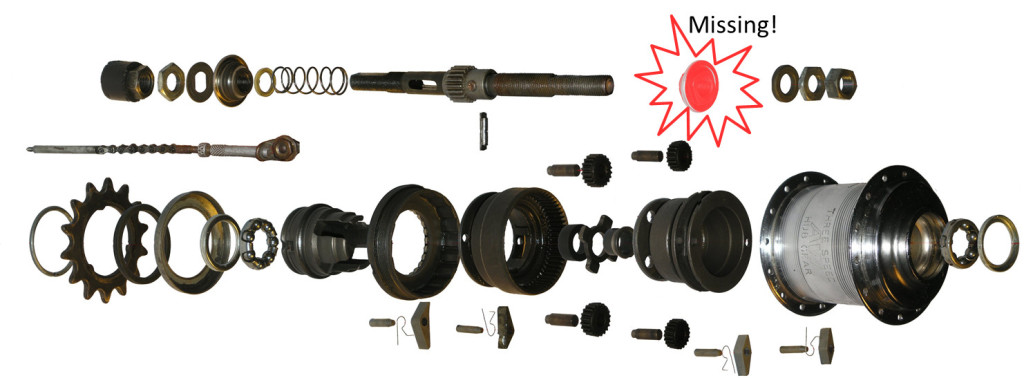
Inventory Reduction is an Outcome, Not an Input
Of course it can save money to have a smaller inventory. However, a smaller inventory is more of a result than a lever you pull. To reduce your inventory, you need to reduce your fluctuations. Depending on the source of your fluctuations, this may be difficult. However, there is often one source of fluctuation that can easily be reduced simply because you artificially introduced it in the first place: your batches!
Reduce Inventory by Reducing Batch Size
Having a batch size larger than 1 is nothing other than an intentionally introduced fluctuation. In the image below, the inventory levels over time are shown for a batch size of 20, 10, and 5. Unsurprisingly, the inventory levels are lower for lower batch sizes. In fact, the average inventory in the example below is almost exactly half of the batch size (i.e., the average inventory is 10, 5, and 2.5 for the batch sizes 20, 10, and 5).
Hence, reducing the batch size is one of the easiest ways to reduce inventory. The above example is a bit of a simplification for only a single batch. However, you probably have multiple batches. Overall, if you halve your batch size and keep the number of batches constant, then you have halved your inventory. Reducing batch size is one of the easiest ways to reduce inventory.
However, before you simply reduce your batch size to the perfect number of 1, keep in mind the reasons why we have inventory in the first place. These batches can save money. For example, your shipping costs or changeover costs may not be zero, and may increase with a smaller batch size. While I would err toward a smaller batch size, I would not completely neglect these costs. It may be beneficial to reduce these costs (e.g., through a SMED workshop) before reducing batch sizes.
Reduce Inventory by Reducing Other Fluctuations
Secondly, your inventory – batched or not – buffers against fluctuations. If you reduce your inventory – regardless if through smaller batch sizes or otherwise – you will eventually have no longer enough to buffer your fluctuations. To reduce the inventory you would have to reduce the fluctuations.One great tool here is pull, which besides reducing fluctuations also gives an upper limit to the inventory. In fact, many activities in lean have as one side effect a reduction in inventory.
By the way, a goal of zero inventory is nonsense. As described above, too little inventory decreases productivity and delivery performance, and may even unintentionally increase inventory.
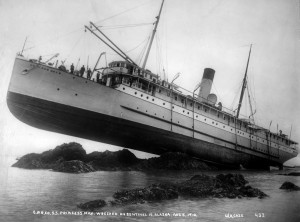
If you are into lean, you probably have heard the worn-out metaphor of the ship floating on water with rocks below. It is mentioned in pretty much every beginner lean course. The water stands for inventory, the rocks for problems, and the ship for your production system. You should lower the water/inventory until you see the rocks/problems, and then fix them before you lower the water even more.
Personally, I am not too fond of this metaphor, as there are too many discrepancies. For one thing, a ship likes to have lots of water under its keel, and the water does not cost the ship anything. In lean, you want to be as close to the rocks as possible. But then, maybe I have heard it just way too often…
In any case, you want to reduce inventory to a level where the problems are still manageable, and – more importantly – fixable. If you find a problem, you need to eliminate the root cause so it does not happen again. This is easier said than done and is usually a lot of hard work. Depending on the source of fluctuations, you could try to work with your suppliers to ensure a more reliable delivery (usually works only if you have power over them), try to understand your customers better for a more accurate prediction of demand, improve maintenance or availability of your system, or a host of many other things. It depends on where your fluctuations come from, and which one you can influence or at least predict. Reducing inventory by reducing fluctuations is one of the reasons Why Leveling (Heijunka) is Important.
If there are more problems than you can handle, then you would actually need to increase inventory. My gut feeling is that in many Western companies this is the case. Inventory was reduced to rock bottom, resulting in bad performance and lots of firefighting. Too little inventory can be as bad as too much!
How to Get to a Low Inventory Level
Achieve Adequate Inventory Level
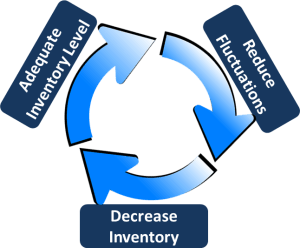 To improve your inventory sensibly without causing chaos, it is advisable to make smaller steps. First, you would need to know if your current inventory level is adequate for the abilities of your manufacturing system. Please do not confuse adequate with desirable. Before we become better, we first need a working current system. If problems related to inventory (missing parts, missed deliveries, …) overwhelm you every day, then you have too little inventory and should increase it. My gut feeling tells me that this is the case in many Western companies.
To improve your inventory sensibly without causing chaos, it is advisable to make smaller steps. First, you would need to know if your current inventory level is adequate for the abilities of your manufacturing system. Please do not confuse adequate with desirable. Before we become better, we first need a working current system. If problems related to inventory (missing parts, missed deliveries, …) overwhelm you every day, then you have too little inventory and should increase it. My gut feeling tells me that this is the case in many Western companies.
Yes, you heard me right. It may be good for you to increase inventory. At the same time I am fully aware that – depending on your bosses – this may damage your career. Even if it is the right thing to do, increasing inventory is a no-go in many companies. And I can’t blame you if you like your career more than the success of the company. Yet, it will make good manufacturing more difficult.
Of course, no amount of inventory will fix all problems – it will actually make problems on its own. Hence, the right inventory does not mean it will be problem-free, but rather that you will have a few problems that you can work on improving.
Reduce Fluctuations
 Once you are at the right inventory level, reduce fluctuations in your system. This includes both those that are self-made (usually the easier one, batch size) and those that are forced on you. Many lean activities have as a primary or secondary effect a reduction in fluctuations. But please note that reducing fluctuations is usually easier said than done.
Once you are at the right inventory level, reduce fluctuations in your system. This includes both those that are self-made (usually the easier one, batch size) and those that are forced on you. Many lean activities have as a primary or secondary effect a reduction in fluctuations. But please note that reducing fluctuations is usually easier said than done.
If you start with adequate level of inventory, the problems that are popping up will show you where to start. At the same time, you should have the time to fix these problems in a way that they will no longer happen. Just waiting for the late material to arrive or the overdue delivery to be shipped will fix the problem, but it won’t prevent it from happening again.
Decrease Inventory
Once your system is improved, there should be less problems popping up. If so, you can reduce inventory. If it works, great! Go on and reduce fluctuations on the next problems that pop up. If your problems become too big, you would need to increase inventory again to get to a workable level. In any case, you would need to repeat the cycle again, starting with an adequate inventory level.
How Low Can I Get?
 Theoretically, you could have an inventory of one piece per process. All your people or machines are busy. Ordered parts arrive exactly when you need them, and products are completed exactly when your customer needs them. It is beautiful, but it is an illusion. There will always be fluctuations, and hence you always need more inventory than one piece per machine.
Theoretically, you could have an inventory of one piece per process. All your people or machines are busy. Ordered parts arrive exactly when you need them, and products are completed exactly when your customer needs them. It is beautiful, but it is an illusion. There will always be fluctuations, and hence you always need more inventory than one piece per machine.
The lower you get your inventory, the more difficult it will be to reduce fluctuations even more. In fact, just standing still will be a lot of work. At one point, the benefit of lower inventory is no longer worth the effort to obtain it. At which inventory level this will happen is difficult to tell. It also depends on your power over suppliers or customers. If you are a car maker, you can dictate the conditions to your suppliers, and your customers have to wait for you. If you are a small company, it will be much harder to convince your suppliers to improve delivery performance. As always, put your effort into the biggest problems you have. Now go out, reduce fluctuations, and organize your industry!

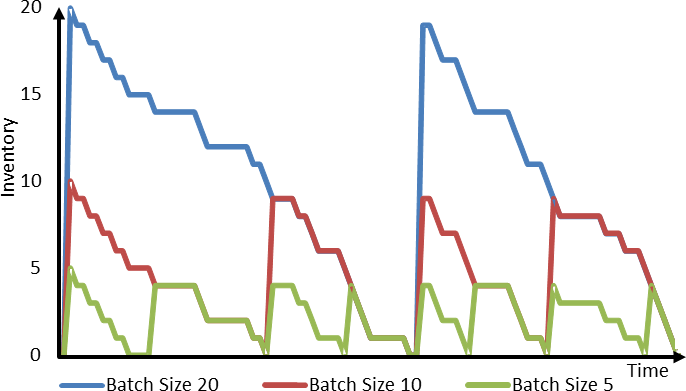
Christoph: At risk of being nit-picky, I would disagree that inventory reduction is a goal of lean. The primary goal of lean is to provide more customer value, flow without stopping, engaging the people in continuous improvement, & pursue perfection. One hugely beneficial outcome of this is reduced inventory.
The reason I am being nit-picky is that I have worked with several companies that have focused on inventory reduction and think they are becoming lean. In fact they are just doing the same traditional management without embracing anything you can call lean. Prof. Bob Emiliani would call this “fake lean”.
Brian
Hi Brian, at one point i looked at many different definitions of lean, and none of them was really satisfactory for me. Unfortunately, I do not have my own. A lot of the points you mention are absolutely valid, although I am not sure if these are all there is to lean.
I agree with you as I said above: “Inventory is not a lever that you can pull. It is more the result of other good lean improvements.” Reducing fluctuations is the key here, both external and self made (e.g. batches). This will improve flow and reduce waste in many different ways, one of them is inventory. Inventory is merely one of the best visible/measurable improvements.
I agree with your nitpicking, focusing only on inventory is not good. It is one of many things that have to come together to make a good production system. Many companies also reduce inventory by “buying less stuff”, but this will actually lead to more inventory (see also post above).
“The more inventory a company has, the less likely they will have what they need.” – Taiichi Ohno
Christoph, How about replacing forecast push MRP with cross enterprise multi echelon pull? That eliminates most of the expediting / use of unplanned capacity / lead-time growth and too much of the wrong stuff/too little of the right stuff/too much overall. Also requires less variability inventory (demand variability < forecast error). Then start on the never ending quest of batch size reduction. Quick win that delivers 'agility thru' stability' and ensures subsequent CI fully hits the bottom line.
Agree with Brian, inventory reduction is a result of applying lean philosophy. Lean thinking is about customer value, value stream, flow, pull and perfection. Under these principles it then comes important benefits such as: inventory reduction, higher quality performance, less waste in the processes, increased customer satisfaction, more turnovers, less space required, improved employee morale and involvement, and many more.
Hi Simon. You are right, pull is one good method to reduce fluctuations and also explicitly to limit inventory. I added this to the post above. Thanks for the comment.
Hi Nur, that is what I say, too. See introduction section of my post at the very top: “Inventory is not a lever that you can pull. It is more the result of other good lean improvements.” This will have other desirable side effects, too, as you mentioned. The only word I stumbled across in your post was “perfection”. Nothing can be perfect, it can always be better. That’s where Kaizen comes in.
Hi Christoph, I understand what you mean, nothing can be perfect, but the higher you aim the higher you reach. I believe that “perfection” is about always trying to find ways to increase value provision, reduce the cost of non-value adding but necessary activities and keep removing succesive layers of waste. Here comes what you said, Kaizen.
Hi Nur, then we have similar views, just using different words. Hence, sounds good to me 🙂
Hi Chris, any hint how this translates in commercial & logistics gergo ? Do Amazon, Portals, Big Wholesellers apply Lean principles and instruments or do they rely on a different school of reference ? I have been doing a lot in depth Lean work from 2001 to today (in an environment which was a bit more technical than the current one; so it was easier do use some standard methods on shopfloor). Find it a bit hard to translate. Being passionate about Lean Thinking any advice welcome. Thanks a lot, Steffen
In my experience of lean , the focus should be on reducing fluctuations / variability in the entire supply chain to achieve the results of true pull.
However due to the very nature of environment of dependent events and fluctuations we cannot achieve results. Hence inventory in the right quantity in the right location is a must to achieve the goal.The question is where to focus( location ) and that I believe should be at the constraint ( bottle neck ).
Hi Steffen, Lean applies to many areas. The term used here is Lean Logistics. Not all tools from manufacturing apply with equal importance, but there too even flow of material,reduction of waste (especially inventory), pull, etc. are impprtant.
Hi Prakash, There are two ways to work with fluctuations: 1) reduce fluctuations e.g. by smaller lot sizes, more stable production, etc. or 2) decouple fluctuation. For decoupling there are actually three ways to decouple 2.1) Inventory, 2.2) capacity, 2.3) time. For more details see The Three Fundamental Ways to Decouple Fluctuations.
Cheers, Chris.
Hola a todos!!
Acabo de acabar el curso de Lean manufacturing y digo que soy una novata!
Pero le digo una cosa que una casa se empeza por abajo no por el tejado.
Mi opinion es que fabricar por tener un inventario costoso no vale la pena!!
Empezamos por la gestión de programar la producción ,tiempos, y muy importante es la demanda de los clientes.
Es muy importante el equilibro de la produccion con la demanda de los clientes.Que queda en inventario tambien se vende que tiene salida mas importante!!Támbien se mira los lotes que no tiene salida.Intentar venderla!!!
El inventario importa mucho de coste y volumen!!!
Un saludo!!
@Brian — If, as Ohno did, you identify unnecessary inventory as a waste category, you are making its elimination a goal. And eliminating unnecessary inventory is reducing inventory. On the other hand, I find the statement “the primary goal of lean is to provide more customer value, flow without stopping, engaging the people in continuous improvement, & pursue perfection” to be overly abstract and ambiguous.
“Customer value” is particularly confusing, because the output of most operations goes to a next operation metaphorically described as an “internal customer.” It’s not really a customer because it doesn’t pay and has no option to buy elsewhere. Where “value” is defined in terms of willingness to pay, “customer value” for internal customers is therefore meaningless. And since shop floor operations are many layers removed from actual, paying customers, the people who perform them have no visibility into willingness to pay.
It’s a whole pointless charade. I have long argued that the only relevant distinction is between what you have to do and what you don’t. And what characterizes what you don’t have to do is that your performance does not degrade in any way when you stop doing it. It’s a good, practical definition of “waste.”
Christoph describes ways to operate at a higher level of performance in every way — quality, delivery, cost,… — with less inventory. Once you have achieved that, you have proved that the extra inventory you used to have was unnecessary.
“Continuous improvement” is also ambiguous. At Toyota, it means pursuing improvement all the time, regardless of scale; elsewhere, it means small, incremental improvements, as opposed to radical changes.
hi, I agree inventory reduction is a result not an input
Inventory reduction is not the goal. Ensuring the correct quantities of inventory is the goal. WIP is seldom helpful. SWIP is critical to flow.
“If I had to reduce my message for management to just a few words, I’d say it all had to do with reducing variation,” wrote W. Edwards Deming. He also observed that very few leaders are able to comprehend what the variation in their data are telling them. “The central problem in management and in leadership…is failure to understand the information in variation.” It will be helpful if those who are interested in dealing with the, as the article states “fluctuations in your system” learn to avoid the mistakes that result from responding incorrectly to the sources of variation. Common causes arise from the system and special causes arise from a specific, identifiable source. Donald Wheeler’s book, “Understanding Variation: The Key to Managing Chaos,” is a effective introduction to the topic while also being an easy read.
HI Eric, in my post I clearly state that inventory reduction is merely an outcome of reducing fluctuations (you call it variation, same thing). Reducing fluctuation allows a lower but still adequate inventory level.